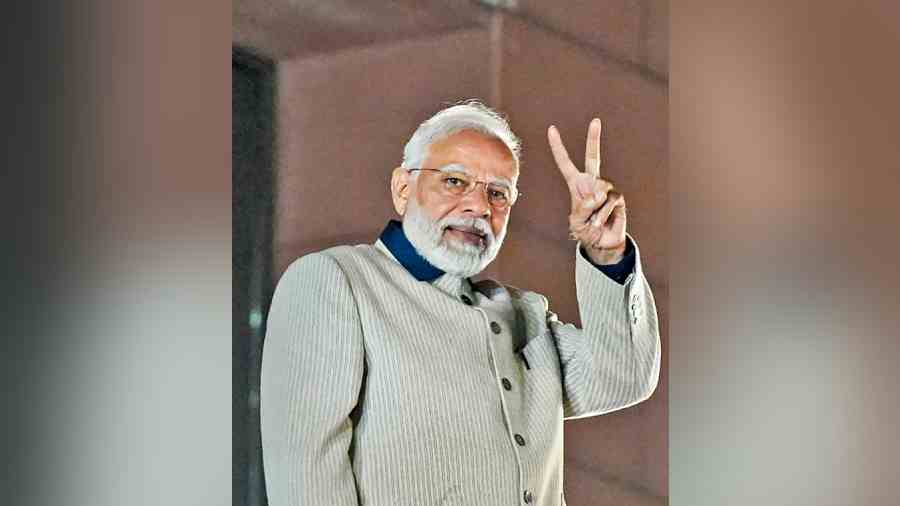Prime Minister Narendra Modi on Thursday led his party to a stunning victory on home turf Gujarat, conjuring a record tally even after a quarter-century of continuous BJP rule in the state, but a rebuff in “second home” Himachal Pradesh exposed the limitations of the Modi model of fighting elections.
The BJP won 156 seats in the 182-member Gujarat Assembly, bettering its previous best of 127 and demolishing the Congress record of 149 set in 1985. Its vote share rose to 52.5 per cent from 49.05 per cent in 2017. The party won big even in tragedy-scarred Morbi.
But Himachal’s voters unseated the BJP and elected the Congress, sticking to their tradition of alternating between the rivals and rejecting Modi’s charm offensive as well as his brazen canvassing of votes in his own name.
The Prime Minister had described the hill state as his “second home”, recalling his days as party-incharge there.
The Congress won 40 of the 68 Assembly seats while the BJP got only 25. The BJP sought to play up the victory in Gujarat to divert attention from not only the defeat in Himachal but also that in the municipal polls in Delhi on Wednesday, no small jolt for a party that says it is led by “the world’s most popular leader”.
The Delhi civic polls, too, had been fought in Modi’s name and the BJP got various chief ministers and Union ministers to campaign — a rarity for a local body election.
Modi had toiled hard in Gujarat, addressing 31 rallies, holding marathon roadshows and converting the contest virtually into a referendum on himself by alleging at his rallies that the Opposition was insulting him.
But similar diligence and a personal line of campaigning fell flat in Himachal despite just a five-year anti-incumbency — less than a fifth of Gujarat’s.
“You don’t have to remember any candidate; just remember the lotus. When you see the lotus while casting your vote, understand that this is the BJP, this is Modi. Your vote for the lotus will directly come to Modi’s account as a blessing,” the Prime Minister had told a rally in Solan, Himachal.
Modi had also tweeted an open letter to Himachal’s voters from his personal handle a day before the November 12 polling, appealing for a “double engine government”.
In Gujarat, new entrant Aam Aadmi Party’s presence appeared to have helped the BJP. It bagged 5 seats, all wrested from the Congress. The Congress won 17 seats, down from 77 the last time.
The AAP’s 13 per cent vote share in Gujarat coincided with a fall of 14 percentage points in the Congress’s share, from 41 per cent in 2017 to 27 per cent. In many seats, the AAP polled between 20 per cent and 30 per cent votes, crippling the Congress.
If the Gujarat results highlighted the AAP’s importance as a possible national-level spoilsport for the Congress, the figures in Himachal underlined it.
The AAP won just over 1 per cent of the vote in the hill state, allowing the Congress to drub the BJP.
The difference between the Congress’s and the BJP’s vote shares was just around 1 per cent in Himachal — 43.09 per cent to 43 per cent — and a better showing by the AAP could well have turned the game around in the BJP’s favour.
The Congress was able to win many seats by very narrow margins in Himachal, courtesy the AAP decision to focus all its energy on Gujarat to try and fulfill party boss Arvind Kejriwal’s ambition of emerging as a national challenger to Modi.
The Congress will now be wary of the possible impact of the AAP in Madhya Pradesh, Chhattisgarh, Rajasthan and Karnataka, where Assembly elections are due next year and where the party has traditionally been involved in a direct fight with the BJP, as it was in Gujarat previously.
In the BJP, questions will be asked of party president J.P. Nadda and the high-profile Union information and broadcasting minister Anurag Thakur, both of whom belong to Himachal.
But the win in Gujarat was of dizzying proportions, emphasising the hold that the Hindutva-laced “Modi model” of development has on the state.
The BJP won by huge margins even from Morbi, where a bridge collapse had killed at least 135 people a month before the polls amid questions about the authorities’ role, and in Godhra, where the BJP candidate had justified the release of the rapists of Bilkis Bano.
The BJP won Morbi by over 62,000 votes and with a vote share of around 60 per cent, suggesting the voters had chosen to close their eyes to the allegations of administrative negligence behind the tragedy.
In Godhra, Chandrasingh Raulji won by more than 35,000 votes, baring the extent of communal polarisation in the state. Raulji was part of the 11-member jail advisory committee that recommended remission of the Bilkis Bano convicts’ life sentences.
Raulji was later quoted as justifying the move, saying the rape-and-murder convicts were Brahmins, and “Brahmins” had “good sanskar (culture)”.
In the elections in December 2002, less than a year after the Godhra riots, the BJP led by Modi as chief minister had won 126 of the 182 seats.












